Belizean vs Bolivian Community Comparison
COMPARE
Belizean
Bolivian
Social Comparison
Social Comparison
Belizeans
Bolivians
1,156
SOCIAL INDEX
9.1/ 100
SOCIAL RATING
320th/ 347
SOCIAL RANK
8,880
SOCIAL INDEX
86.3/ 100
SOCIAL RATING
42nd/ 347
SOCIAL RANK
Bolivian Integration in Belizean Communities
The statistical analysis conducted on geographies consisting of 94,401,694 people shows a poor negative correlation between the proportion of Bolivians within Belizean communities in the United States with a correlation coefficient (R) of -0.187. On average, for every 1% (one percent) increase in Belizeans within a typical geography, there is a decrease of 0.022% in Bolivians. To illustrate, in a geography comprising of 100,000 individuals, a rise of 1,000 Belizeans corresponds to a decrease of 22.3 Bolivians.
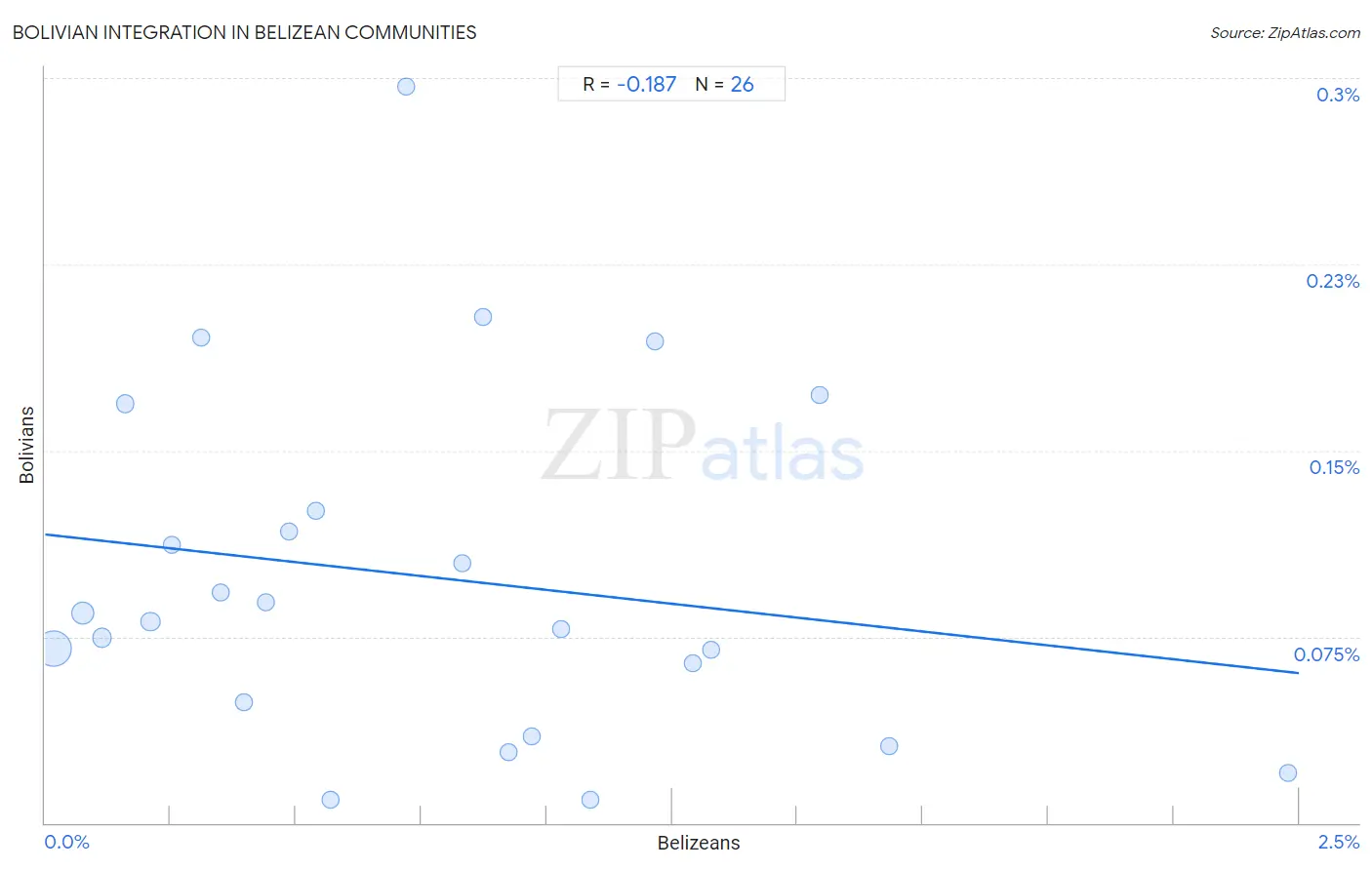
Belizean vs Bolivian Income
When considering income, the most significant differences between Belizean and Bolivian communities in the United States are seen in householder income over 65 years ($54,580 compared to $74,245, a difference of 36.0%), householder income ages 45 - 64 years ($88,684 compared to $118,871, a difference of 34.0%), and median household income ($77,028 compared to $102,195, a difference of 32.7%). Conversely, both communities are more comparable in terms of householder income under 25 years ($51,094 compared to $58,506, a difference of 14.5%), median female earnings ($37,429 compared to $43,445, a difference of 16.1%), and median earnings ($42,702 compared to $52,005, a difference of 21.8%).

| Income Metric | Belizean | Bolivian |
| Per Capita Income | Tragic $39,097 | Exceptional $49,526 |
| Median Family Income | Tragic $90,880 | Exceptional $119,479 |
| Median Household Income | Tragic $77,028 | Exceptional $102,195 |
| Median Earnings | Tragic $42,702 | Exceptional $52,005 |
| Median Male Earnings | Tragic $48,358 | Exceptional $61,066 |
| Median Female Earnings | Tragic $37,429 | Exceptional $43,445 |
| Householder Age | Under 25 years | Tragic $51,094 | Exceptional $58,506 |
| Householder Age | 25 - 44 years | Tragic $84,534 | Exceptional $109,372 |
| Householder Age | 45 - 64 years | Tragic $88,684 | Exceptional $118,871 |
| Householder Age | Over 65 years | Tragic $54,580 | Exceptional $74,245 |
| Wage/Income Gap | Exceptional 21.2% | Tragic 26.8% |
Belizean vs Bolivian Poverty
When considering poverty, the most significant differences between Belizean and Bolivian communities in the United States are seen in receiving food stamps (14.8% compared to 9.3%, a difference of 58.7%), child poverty under the age of 16 (19.9% compared to 13.2%, a difference of 50.0%), and child poverty among boys under 16 (19.9% compared to 13.3%, a difference of 49.8%). Conversely, both communities are more comparable in terms of single father poverty (16.2% compared to 14.7%, a difference of 10.3%), female poverty among 18-24 year olds (20.1% compared to 17.4%, a difference of 15.2%), and single male poverty (13.4% compared to 11.2%, a difference of 19.5%).
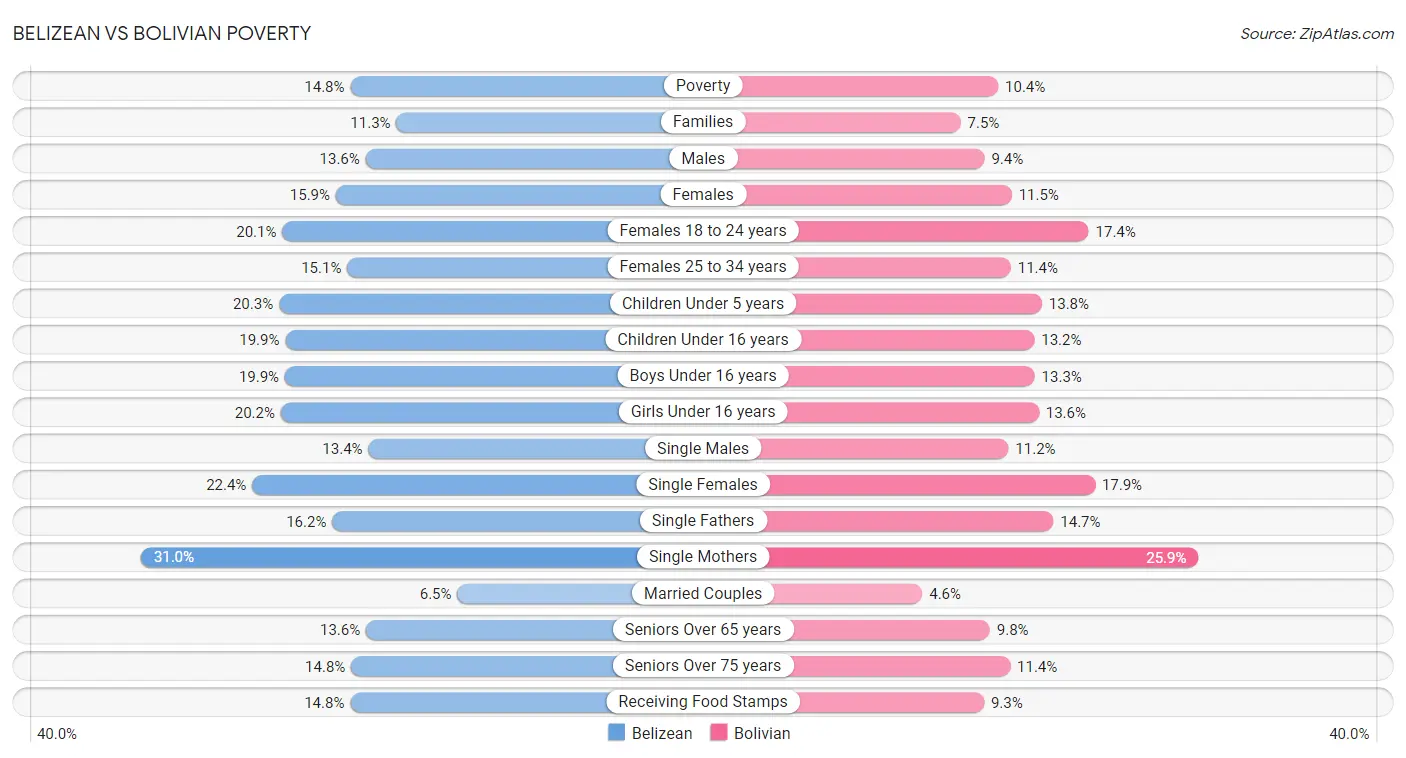
| Poverty Metric | Belizean | Bolivian |
| Poverty | Tragic 14.8% | Exceptional 10.4% |
| Families | Tragic 11.3% | Exceptional 7.5% |
| Males | Tragic 13.6% | Exceptional 9.4% |
| Females | Tragic 15.9% | Exceptional 11.5% |
| Females 18 to 24 years | Average 20.1% | Exceptional 17.4% |
| Females 25 to 34 years | Tragic 15.1% | Exceptional 11.4% |
| Children Under 5 years | Tragic 20.3% | Exceptional 13.8% |
| Children Under 16 years | Tragic 19.9% | Exceptional 13.2% |
| Boys Under 16 years | Tragic 19.9% | Exceptional 13.3% |
| Girls Under 16 years | Tragic 20.2% | Exceptional 13.6% |
| Single Males | Tragic 13.4% | Exceptional 11.2% |
| Single Females | Tragic 22.4% | Exceptional 17.9% |
| Single Fathers | Average 16.2% | Exceptional 14.7% |
| Single Mothers | Tragic 31.0% | Exceptional 25.9% |
| Married Couples | Tragic 6.5% | Exceptional 4.6% |
| Seniors Over 65 years | Tragic 13.6% | Exceptional 9.8% |
| Seniors Over 75 years | Tragic 14.8% | Exceptional 11.4% |
| Receiving Food Stamps | Tragic 14.8% | Exceptional 9.3% |
Belizean vs Bolivian Unemployment
When considering unemployment, the most significant differences between Belizean and Bolivian communities in the United States are seen in male unemployment (6.5% compared to 4.7%, a difference of 38.5%), unemployment among ages 35 to 44 years (5.7% compared to 4.1%, a difference of 36.6%), and unemployment among ages 30 to 34 years (6.6% compared to 4.9%, a difference of 35.8%). Conversely, both communities are more comparable in terms of unemployment among seniors over 75 years (8.4% compared to 8.0%, a difference of 4.8%), unemployment among women with children ages 6 to 17 years (9.1% compared to 8.5%, a difference of 6.0%), and unemployment among ages 65 to 74 years (5.7% compared to 5.1%, a difference of 10.0%).
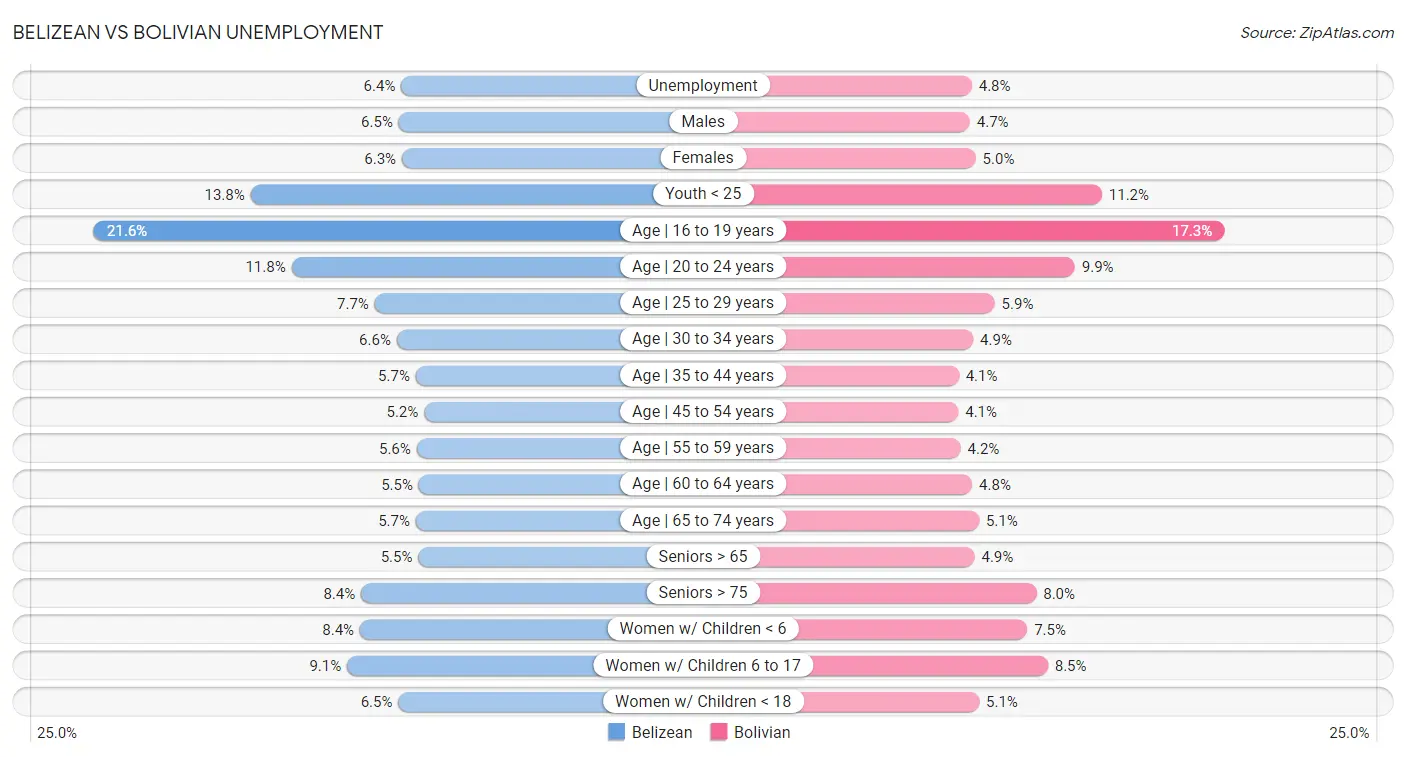
| Unemployment Metric | Belizean | Bolivian |
| Unemployment | Tragic 6.4% | Exceptional 4.8% |
| Males | Tragic 6.5% | Exceptional 4.7% |
| Females | Tragic 6.3% | Exceptional 5.0% |
| Youth < 25 | Tragic 13.8% | Exceptional 11.2% |
| Age | 16 to 19 years | Tragic 21.6% | Excellent 17.3% |
| Age | 20 to 24 years | Tragic 11.8% | Exceptional 9.9% |
| Age | 25 to 29 years | Tragic 7.7% | Exceptional 5.9% |
| Age | 30 to 34 years | Tragic 6.6% | Exceptional 4.9% |
| Age | 35 to 44 years | Tragic 5.7% | Exceptional 4.1% |
| Age | 45 to 54 years | Tragic 5.2% | Exceptional 4.1% |
| Age | 55 to 59 years | Tragic 5.6% | Exceptional 4.2% |
| Age | 60 to 64 years | Tragic 5.5% | Good 4.8% |
| Age | 65 to 74 years | Tragic 5.7% | Exceptional 5.1% |
| Seniors > 65 | Tragic 5.5% | Exceptional 4.9% |
| Seniors > 75 | Exceptional 8.4% | Exceptional 8.0% |
| Women w/ Children < 6 | Tragic 8.4% | Good 7.5% |
| Women w/ Children 6 to 17 | Fair 9.1% | Exceptional 8.5% |
| Women w/ Children < 18 | Tragic 6.5% | Exceptional 5.1% |
Belizean vs Bolivian Labor Participation
When considering labor participation, the most significant differences between Belizean and Bolivian communities in the United States are seen in in labor force | age 16-19 (32.8% compared to 36.0%, a difference of 9.9%), in labor force | age > 16 (64.8% compared to 68.2%, a difference of 5.2%), and in labor force | age 45-54 (80.8% compared to 84.9%, a difference of 5.1%). Conversely, both communities are more comparable in terms of in labor force | age 20-24 (73.4% compared to 75.2%, a difference of 2.4%), in labor force | age 30-34 (83.5% compared to 86.1%, a difference of 3.1%), and in labor force | age 35-44 (83.1% compared to 86.1%, a difference of 3.5%).

| Labor Participation Metric | Belizean | Bolivian |
| In Labor Force | Age > 16 | Poor 64.8% | Exceptional 68.2% |
| In Labor Force | Age 20-64 | Tragic 78.2% | Exceptional 81.7% |
| In Labor Force | Age 16-19 | Tragic 32.8% | Fair 36.0% |
| In Labor Force | Age 20-24 | Tragic 73.4% | Good 75.2% |
| In Labor Force | Age 25-29 | Tragic 83.1% | Exceptional 86.1% |
| In Labor Force | Age 30-34 | Tragic 83.5% | Exceptional 86.1% |
| In Labor Force | Age 35-44 | Tragic 83.1% | Exceptional 86.1% |
| In Labor Force | Age 45-54 | Tragic 80.8% | Exceptional 84.9% |
Belizean vs Bolivian Family Structure
When considering family structure, the most significant differences between Belizean and Bolivian communities in the United States are seen in births to unmarried women (37.0% compared to 28.5%, a difference of 30.2%), single mother households (7.6% compared to 5.8%, a difference of 29.9%), and married-couple households (42.2% compared to 49.2%, a difference of 16.4%). Conversely, both communities are more comparable in terms of family households (64.8% compared to 66.5%, a difference of 2.6%), average family size (3.39 compared to 3.29, a difference of 3.0%), and family households with children (27.8% compared to 29.5%, a difference of 6.2%).

| Family Structure Metric | Belizean | Bolivian |
| Family Households | Excellent 64.8% | Exceptional 66.5% |
| Family Households with Children | Exceptional 27.8% | Exceptional 29.5% |
| Married-couple Households | Tragic 42.2% | Exceptional 49.2% |
| Average Family Size | Exceptional 3.39 | Exceptional 3.29 |
| Single Father Households | Tragic 2.6% | Excellent 2.3% |
| Single Mother Households | Tragic 7.6% | Exceptional 5.8% |
| Currently Married | Tragic 42.2% | Exceptional 48.1% |
| Divorced or Separated | Fair 12.1% | Exceptional 11.2% |
| Births to Unmarried Women | Tragic 37.0% | Exceptional 28.5% |
Belizean vs Bolivian Vehicle Availability
When considering vehicle availability, the most significant differences between Belizean and Bolivian communities in the United States are seen in no vehicles in household (14.3% compared to 8.6%, a difference of 67.0%), 2 or more vehicles in household (51.0% compared to 58.3%, a difference of 14.3%), and 3 or more vehicles in household (18.6% compared to 20.8%, a difference of 12.2%). Conversely, both communities are more comparable in terms of 1 or more vehicles in household (85.7% compared to 91.5%, a difference of 6.8%), 4 or more vehicles in household (6.3% compared to 6.8%, a difference of 8.8%), and 3 or more vehicles in household (18.6% compared to 20.8%, a difference of 12.2%).

| Vehicle Availability Metric | Belizean | Bolivian |
| No Vehicles Available | Tragic 14.3% | Exceptional 8.6% |
| 1+ Vehicles Available | Tragic 85.7% | Exceptional 91.5% |
| 2+ Vehicles Available | Tragic 51.0% | Exceptional 58.3% |
| 3+ Vehicles Available | Tragic 18.6% | Exceptional 20.8% |
| 4+ Vehicles Available | Average 6.3% | Exceptional 6.8% |
Belizean vs Bolivian Education Level
When considering education level, the most significant differences between Belizean and Bolivian communities in the United States are seen in doctorate degree (1.4% compared to 2.4%, a difference of 69.7%), professional degree (3.6% compared to 5.6%, a difference of 57.3%), and master's degree (12.4% compared to 19.3%, a difference of 55.2%). Conversely, both communities are more comparable in terms of nursery school (97.0% compared to 97.6%, a difference of 0.65%), kindergarten (97.0% compared to 97.6%, a difference of 0.65%), and 1st grade (96.9% compared to 97.6%, a difference of 0.67%).
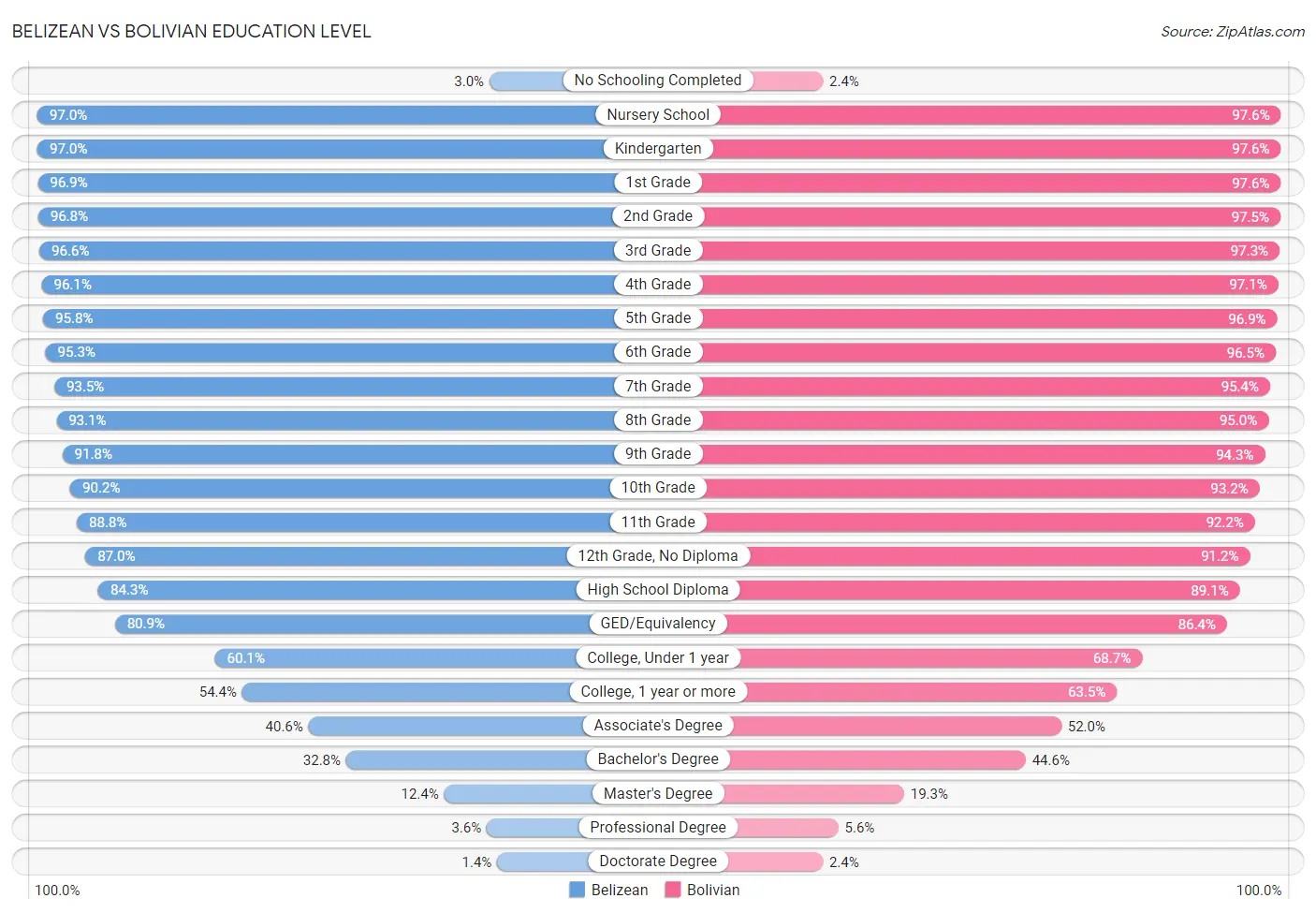
| Education Level Metric | Belizean | Bolivian |
| No Schooling Completed | Tragic 3.0% | Tragic 2.4% |
| Nursery School | Tragic 97.0% | Tragic 97.6% |
| Kindergarten | Tragic 97.0% | Tragic 97.6% |
| 1st Grade | Tragic 96.9% | Tragic 97.6% |
| 2nd Grade | Tragic 96.8% | Tragic 97.5% |
| 3rd Grade | Tragic 96.6% | Tragic 97.3% |
| 4th Grade | Tragic 96.1% | Tragic 97.1% |
| 5th Grade | Tragic 95.8% | Tragic 96.9% |
| 6th Grade | Tragic 95.3% | Tragic 96.5% |
| 7th Grade | Tragic 93.5% | Tragic 95.4% |
| 8th Grade | Tragic 93.1% | Tragic 95.0% |
| 9th Grade | Tragic 91.8% | Tragic 94.3% |
| 10th Grade | Tragic 90.2% | Tragic 93.2% |
| 11th Grade | Tragic 88.8% | Fair 92.2% |
| 12th Grade, No Diploma | Tragic 87.0% | Average 91.2% |
| High School Diploma | Tragic 84.3% | Average 89.1% |
| GED/Equivalency | Tragic 80.9% | Excellent 86.4% |
| College, Under 1 year | Tragic 60.1% | Exceptional 68.7% |
| College, 1 year or more | Tragic 54.4% | Exceptional 63.5% |
| Associate's Degree | Tragic 40.6% | Exceptional 52.0% |
| Bachelor's Degree | Tragic 32.8% | Exceptional 44.6% |
| Master's Degree | Tragic 12.4% | Exceptional 19.3% |
| Professional Degree | Tragic 3.6% | Exceptional 5.6% |
| Doctorate Degree | Tragic 1.4% | Exceptional 2.4% |
Belizean vs Bolivian Disability
When considering disability, the most significant differences between Belizean and Bolivian communities in the United States are seen in disability age 35 to 64 (12.0% compared to 8.9%, a difference of 33.8%), ambulatory disability (6.5% compared to 5.1%, a difference of 29.0%), and vision disability (2.4% compared to 1.9%, a difference of 28.3%). Conversely, both communities are more comparable in terms of hearing disability (2.8% compared to 2.6%, a difference of 6.5%), disability age 5 to 17 (5.4% compared to 5.0%, a difference of 8.8%), and cognitive disability (18.0% compared to 16.5%, a difference of 9.1%).
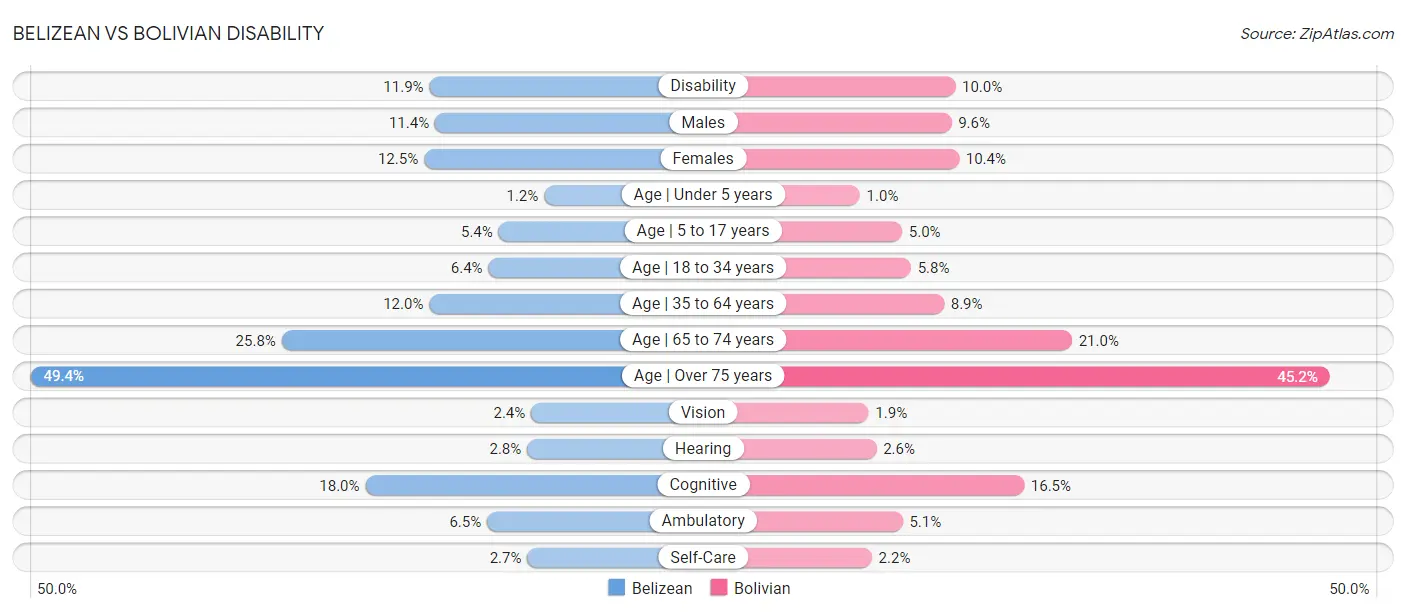
| Disability Metric | Belizean | Bolivian |
| Disability | Poor 11.9% | Exceptional 10.0% |
| Males | Fair 11.4% | Exceptional 9.6% |
| Females | Tragic 12.5% | Exceptional 10.4% |
| Age | Under 5 years | Exceptional 1.2% | Exceptional 1.0% |
| Age | 5 to 17 years | Exceptional 5.4% | Exceptional 5.0% |
| Age | 18 to 34 years | Excellent 6.4% | Exceptional 5.8% |
| Age | 35 to 64 years | Tragic 12.0% | Exceptional 8.9% |
| Age | 65 to 74 years | Tragic 25.8% | Exceptional 21.0% |
| Age | Over 75 years | Tragic 49.4% | Exceptional 45.2% |
| Vision | Tragic 2.4% | Exceptional 1.9% |
| Hearing | Exceptional 2.8% | Exceptional 2.6% |
| Cognitive | Tragic 18.0% | Exceptional 16.5% |
| Ambulatory | Tragic 6.5% | Exceptional 5.1% |
| Self-Care | Tragic 2.7% | Exceptional 2.2% |